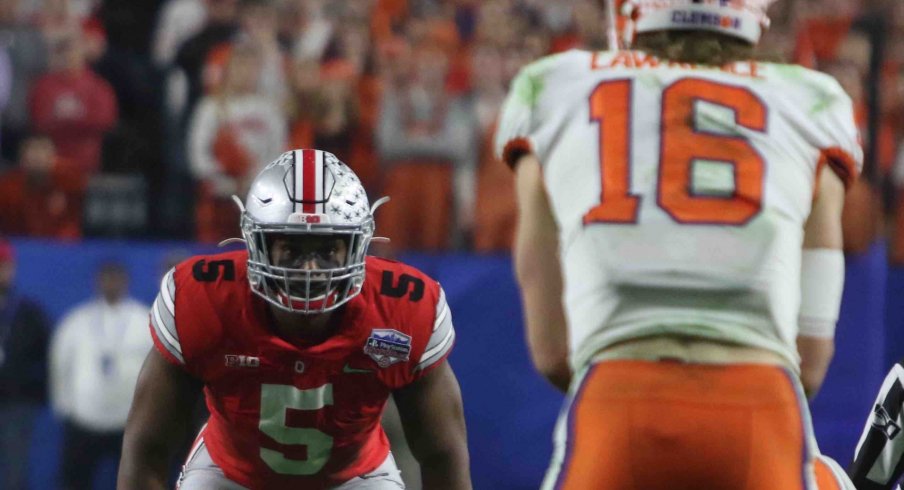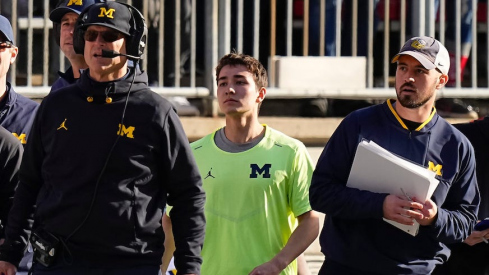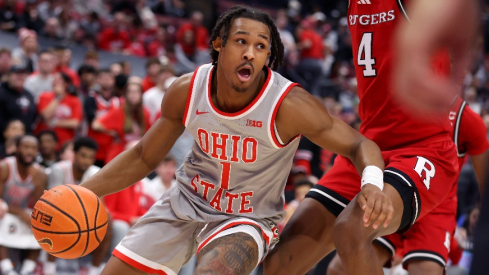"They know us very well. They always have really good schemes. So we'll have to continue to do a great job preparing so that when we get out there on Friday night, you know, we're anticipating as opposed to reacting." - Ryan Day
Let's dispense with the formalities. While preparing for their fourth meeting in seven years - all of which have come in New Years Six bowl games - the 'R' word continues to be brought up.
Except, as many Buckeye fans like to remind residents of Ann Arbor, or even State College, both sides must be capable of winning for a matchup to be considered a true rivalry. Thus far in the four meetings between these two programs, the team in Scarlet and Gray has yet to pass that test.
Now, facing a rematch of what was the best, and likely the most physical, game of the entire 2019 college football season, the Buckeyes once again have their work cut out for them. While both rosters have been reshaped over the past year, giving each team a slightly different fingerprint, much of the same gameplan that brought Ohio State so close to winning one year ago remains its most likely path to success today.
"Even though the structure is similar, each team, just like us on offense, each unit will have its own identity," said Clemson offensive coordinator Tony Elliott this week. "They are going to play to the strengths of their identity. They are going to test and make sure that we corrected the issues from last year. But I think it's just going to come down -- at the end of the day, you get to this point doing what you do. You're not going to get away from what your base offense is. You're going to have a couple of gameplan wrinkles."
As is always the case when two titans face-off, the fundamentals will make the ultimate difference. The team that blocks and tackles better will ultimately come out victorious.
But there are a few additional areas upon which Day and his staff should focus during their Sugar Bowl prep.
When Clemson Has the Ball
Disrupt Clemson's Gap Scheme with Interior Penetration
As has been the case for nearly a decade, the Tiger rushing attack relies heavily on the option game - including a QB run threat, quick pass, or both in addition to any handoff or pitch. This desire to put defenders in conflict and create more ways to move the ball on any single play remains a foundational aspect of the system Chad Morris installed in 2011.
While everyone knows about the talents of tailback Travis Etienne, he does his work behind an offensive line that is one of the (relatively) less talented units on the Clemson roster. Left tackle Jackson Carmen was a five-star recruit, but the Tiger interior offensive linemen lack the same size or reputation.
As a result, the Clemson offense doesn't try to maul opponents with inside zone blocks, trying to simply push defenders straight backward. Rather, it relies heavily upon pulling backside players to overwhelm defenses on one side.
Offensive coordinator Tony Elliott's favorite scheme appears to be the Counter, in which the center or backside guard and a tight end pull across the formation to lead a runner through the opposite C-gap. When executed properly, the play can be devastating, creating an additional gap that the opposition simply can't defend.
But the best way to slow down such a scheme is with interior penetration.
As the puller vacates his spot on the line, an open gap is created, through which a quick defender like Haskell Garrett or Tommy Togiai might be able to shoot into the backfield. But those defensive tackles need not aim for the runner on every play.
Simply knocking the pullers off their tracks will leave the runner stuck in the backfield with nowhere to go. Davon Hamilton made such plays on multiple occasions in last year's game, forcing the Tigers to find new ways to run the ball.
As the Buckeyes and many others have learned the hard way over the years, the Tigers have an emergency option in the form of Trevor Lawrence's legs. The star QB has already shown the OSU defense just how dangerous he can be as a runner, rushing 16 times for 107 yards in last year's CFP semifinal.
The Tigers like to use him as both an inside and outside option, swapping roles between him and Etienne quite often with BASH (back away sweep) concepts. As he showed against Notre Dame in the ACC title game, Lawrence is equally adept at executing schemes like Counter for huge gains, which he converted for a 33-yard touchdown.
But slowing Lawrence in the run game is most easily done by the interior tackles as well, with quick penetration preventing the big QB from ever getting out of the blocks.
"Usually, guys who are that tall and that big don’t really run but like we know, the game is changing," Garrett said of Lawrence. "Quarterbacks are becoming dual threats. He can do it in the air and do it on the ground."
Get Hands on the Tiger Receivers
Though the Tigers have long built their offense on spread-option concepts, they've always seemed to feature some of the nation's best wide receivers. From DeAndre Hopkins to Sammy Watkins to Mike Williams to Tee Higgins and Justyn Ross last season, there always seems to be an All-American wideout wearing an orange helmet with a paw logo.
This year, the mantle of 'top playmaker outside' goes to Amari Rodgers. The All-ACC receiver hauled in 69 passes for 966 and 7 touchdowns this season, leading his team in each category.
Lining up both outside and in the slot, the dynamic wideout has shown both the lateral quickness and straight-line speed needed to separate from defenders downfield.
But unlike the other Clemson wideouts listed above, Rodgers isn't the same physical specimen we're used to seeing. The stocky, 5'10" 210-pounder is built more like a running back, meaning he's not going to win many jump balls in mid-air.
In last season's CFP semifinal, however, we saw little of that anyway. Despite the 6'4" frames of Higgins and Justyn Ross, the duo of starting Tiger receivers was held to just 80 yards combined.
One major reason was the increased amount of press coverage shown by Ohio State's corners. As former coordinator Jeff Hafley told Pete Thamel on the Yahoo Sports College Podcast this week, he and the other Buckeye coaches didn't think the Clemson receivers were really challenged at all last year, leading to the bump-and-run tactics shown frequently by Jeffrey Okudah and Damon Arnette in the Fiesta Bowl.
But the tactic seems to have translated to this season as well. When Hafley's Boston College squad faced off with the Tigers (albeit while Lawrence was out battling COVID), his DBs found some success by mixing in press coverage.
Rodgers (lined up at the very top of the screen in the example below) seemed to struggle to create separation in these instances, leaving backup quarterback D.J. Uiagalelei with nowhere to throw the football.
Hafley added in the interview that the Buckeyes can't simply rely on this tactic, however. His former team will need to be thoughtful about when and where they mix man and zone coverages, when they blitz and when they drop eight, and when to press up on the receivers or play off with a soft cushion.
But unlike many of the Tigers' opponents who live in fear of getting beat deep, the Buckeyes must not be afraid to go back to the well of press-man coverage.
"They are probably going to try to attack us the same way, I would imagine," Elliott said of Ohio State's plan to slow his passing attack. "Get up there and press our guys and see if they can have more success. Who's going to have more success -- their corners or our receivers in terms of winning the matchup at the line of scrimmage?"
Contain Etienne in the Passing Game
As nearly any OSU fan will tell you, of course, the most dangerous receiver on the field in last season's Fiesta Bowl was Etienne. The shifty back picked up 98 yards on just three catches, including a 53-yard screen pass that gave his team the lead midway through the third quarter.
The ability to shed multiple Buckeye tacklers in the open field remains his strong suit, and one Lawrence relies heavily upon as a check-down option when his receivers fail to separate outside.
But not all of his 44 catches have been as a last option. Rather, Elliott and his staff try to get their star the ball on the edges via designed screens and swing passes in every game.
There is no real schematic way to shut this down, although ensuring the right defender is responsible for him in man-coverage is certainly a good place to start. But not only must that defender have the speed to keep up with him, but he must be a sure tackler in the open field, capable of corralling the talented runner before he can build up momentum.
But as Hafley's defense showed back in October, the best way to blow up these screens is by never letting him touch the ball in the first place.
When the defensive end (#11) sees Etienne release after a slight delay, the big defender immediately peels off his rush lane and follows the back out into the flat, forcing the QB to throw the ball away.
There's no doubt that Larry Johnson and Hafley's former colleagues have been drilling such actions for the last 10 days, hoping to cage the Tigers' most dynamic playmaker.
When Ohio State Has The Ball
Isolate Olave & Wilson Against the Safeties
Last season, Brent Venables was forced to adapt to the personnel at hand, playing six and seven defensive backs regularly while blitzing from every conceivable angle to create pressure. This season, the veteran coordinator appears to have a much more balanced approach.
With an infusion of talent in the form of blue-chip freshmen Bryan Bresee and Myles Murphy, Venables can rely more on a traditional four-man front to create pressure on the quarterback. While he still blitzes plenty, the Tigers haven't had to be quite as creative when it comes to defending opponents.
One thing that hasn't changed is the multitude of pattern-matching coverages Venables calls in every game. His secondaries will show both one or two-deep safeties and rely heavily on their safeties to take care of business between the numbers while five-star cornerbacks like Derion Kendrick man the outside.
But although safeties Lannden Zanders, Joseph Charleston, and Nolan Turner (who will miss the first half due to a targeting penalty in the ACC championship game) can line up all over the field, they can be left effectively on an island against receivers in the slot when certain match coverages are called.
In these situations, the advantage is in favor of the offense, especially when a receiver as talented as Chris Olave or Garrett Wilson fills that role.
"He's a great player," Venables said of Olave, who beat Turner one-on-one in the slot for a touchdown early in the fourth quarter of last year's matchup. "[He] can take the top off the defense, very savvy. Really understands the ball and can make all the competitive plays. He's got speed, length, size, toughness, savviness. This will be the best group of receivers that we've played against this year. So we'll be challenged for sure. But Chris is a terrific player."
Against a team as deep and talented as Clemson, Ohio State must take advantage of the areas in which there is a clear mismatch in its favor. Manipulating formations and coverage to force one of the Clemson safeties to cover these talented receivers alone is perhaps the biggest such edge Ryan Day will find all game.
Make Life Difficult with Varied Tempos and Pre-Snap Motion
Speaking of Venables' system, his ability to "predict" the opponent's play-call seems unmatched in the current landscape of college football. What had once been an open secret among coaches is no longer taboo, after Pat Forde of SI detailed the manner in which the nation's top-paid assistant coach has built a successful system of sign-stealing.
With the prevalence of no-huddle offenses and the accompanying hand signals to relay a call from the offense's sideline, Venables has a small army of analysts and interns who work to not only break down opponents' film before a game but relay that info to him in real-time.
This information allows him to match the calls of an opposing offense with the antidote, sending a blitz in the direction of a run or dialing up the perfect coverage to a pass. While the Tigers don't succeed at doing so on every play, the amount of seemingly perfect calls from the Clemson D was not lost on Venables' opposing play-caller.
Ryan Day's full answer when asked about Clemson defensive coordinator Brent Venables pic.twitter.com/1uZouYho4k
— Colin Hass-Hill (@chasshill) December 28, 2020
Rather than litigating the ethics of stealing an opponent's signs, the Buckeyes should instead focus on finding ways to minimize its effectiveness. One such way is the use of different tempos when they have the ball - both running uptempo and snapping the ball quickly or going old school and actually huddling with a runner sending in the play.
The Buckeyes even have evidence that the former will work when watching the tape of last year's matchup.
Facing a fourth-and-short, Justin Fields and the Buckeyes lined up quickly before looking to the sideline for an adjustment. Yet just as their opponents did the same, the QB ran up under center and quickly took the snap before falling forward, catching the defense completely unprepared.
The flip side to Venables' attempt to call the perfect defense for a given situation is the added complexity that must be immediately communicated to all 11 players on the field. As a result, the Tiger defense can be caught out of position when teams shift or motion following those last-second play-calls.
Even against the most minor shifts, the Clemson defense can fail to adapt on the fly, given all its moving parts.
The more the Buckeyes can do to not only muddy what Venables sees pre-snap, but also what his players have to adjust to on the fly, the more success they're likely to find.
Don't Forget What Got Them Here
For all the scheming and preparation, what will ultimately lift Ohio State past Clemson is the bruising run game upon which the entire offense is built. Though their opponents feature the best rushing defense of all four CFP semifinalists (at least, on paper), the Buckeyes hold an advantage in this aspect.
No Power-5 team has run the ball more effectively than Ohio State, and the key to this success has not been schematic. Rather, the massive and talented offensive line continues to push opponents around, allowing Trey Sermon and Master Teague III to find the open gap in the base, off-tackle zone concept.
This is the same concept that broke J.K. Dobbins for a 67-yard touchdown to open the scoring in last year's contest. Despite facing a loaded box with six defenders plus a cheating safety, the OSU O-line created enough of a push to create a cutback lane through which Dobbins exploded, reaching the end zone untouched.
Though Venables and his team will surely have eyes on Sermon following his record-setting effort in the Big Ten championship, the veteran back should trust the crew opening holes for him.
With Josh Myers and Thayer Munford joining all-everything guard Wyatt Davis along with tight ends Luke Farrell and Jeremy Ruckert, the Buckeye blockers will be motivated to build on their 196-yard performance one year ago. That effort was the most an otherwise stingy Clemson front gave up in 2019, and there's plenty of reason to believe history will repeat itself.
By establishing a steady run game early on, the deep play-action passing game should be wide open, giving Fields plenty of chances to look downfield for his dangerous receivers and creating the balance Day looks for each week.
"We always have to put pressure on the defense, and throwing the ball is a huge part of that. That also opens up the run game, and I think that's part of how you attack teams," the OSU head coach said of his play-calling strategy this week. "We're always looking for that balance. And being aggressive is both. It's sometimes playing with tempo. It's sometimes taking shots. But at the end of the day, if you're forcing the team to defend the entire sideline and run and pass and the quarterback run, I think that's when you put the most stress on the defense."



